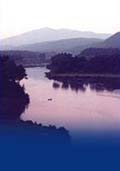
|
New England's biggest river is four hundred miles of power and beauty - a special place to enjoy on your boat. Here's how and where. When you go,
For information on the river in Massachusetts and Connecticut, contact the Connecticut River Watershed Council. Map 4 ~ Lower Fifteen Mile Falls Map 5 ~ Woodsville/Wells River Map 9 ~ In the Shadow of Mt. Ascutney Map 10 ~ Weathersfield Bow Region Map 1 ~ The Connecticut LakesPrinter friendly map. Welcome to the Headwaters region of the
Connecticut River. Over 400 miles from the sea, the
river is wild and cold, with trout to match. The
Connecticut rises in tiny Fourth Lake, accessible
by a footpath along the US/Canadian border and then
through protected land. Which of several outlets
actually becomes the river depends on the mood of
resident beaver. The infant river is too small for navigation between the upper lakes. Watch the roadside wallows on your travels along Route 3, known as Moose Alley. Enjoy the Common Loons, which nest throughout the region, from a distance. Get too close, and you could disturb the adults or threaten their young. If a loon starts to repeatedly dip its bill, splash in the water, or flash its white belly in your direction, back off. Artificial nesting islands set up on some of the lakes help loons raise their chicks away from nest predators and secure from water level changes. Keep your wake low near these structures, and respect warning buoys. Lead sinkers have been banned in NH to protect waterfowl like loons, which suffer from lead poisoning after ingesting them. Loons need their privacy, but aren’t shy about contributing to the night music of the lakes. To learn more about loons, contact the Audubon Society of NH’s Loon Preservation Committee at 603-476-5666.
The four Connecticut Lakes are natural impoundments along the river, although hydro dams have raised the levels of First and Second Lakes. Lake Francis was created in the 1940s to provide flood control. The three-mile stretch of river between First Lake and Lake Francis is expert canoeing and kayaking water only. Be aware of water releases from the dams. Thanks to a 1998 agreement with the hydro power company, some 3000 acres surrounding the lakes will be permanently protected from development and will continue to provide the beautiful backdrop you see today. These pristine lakes deserve the utmost respect from boaters. If you have brought your boat from out of state, wash it carefully to avoid introducing aquatic exotics to the river system. For more information, see introduction. Marine Patrol: Toll Free in NH (1-877-642-9700) or 603-293-2037. For the safety of all, please call if you observe illegal or dangerous boating activity. Information on current and projected flows at Connecticut River mainstem dams is available through TransCanada Hydro Northeast. |
|||||||||||||
 Third,
Second, and First Connecticut Lakes are next in the
chain, offering fine, deep habitat for a renowned
fishery that includes landlocked salmon and lake
trout. A stiff breeze can raise a strong chop, so
be careful if you are canoeing on a windy day.
Third,
Second, and First Connecticut Lakes are next in the
chain, offering fine, deep habitat for a renowned
fishery that includes landlocked salmon and lake
trout. A stiff breeze can raise a strong chop, so
be careful if you are canoeing on a windy day. Click
Click